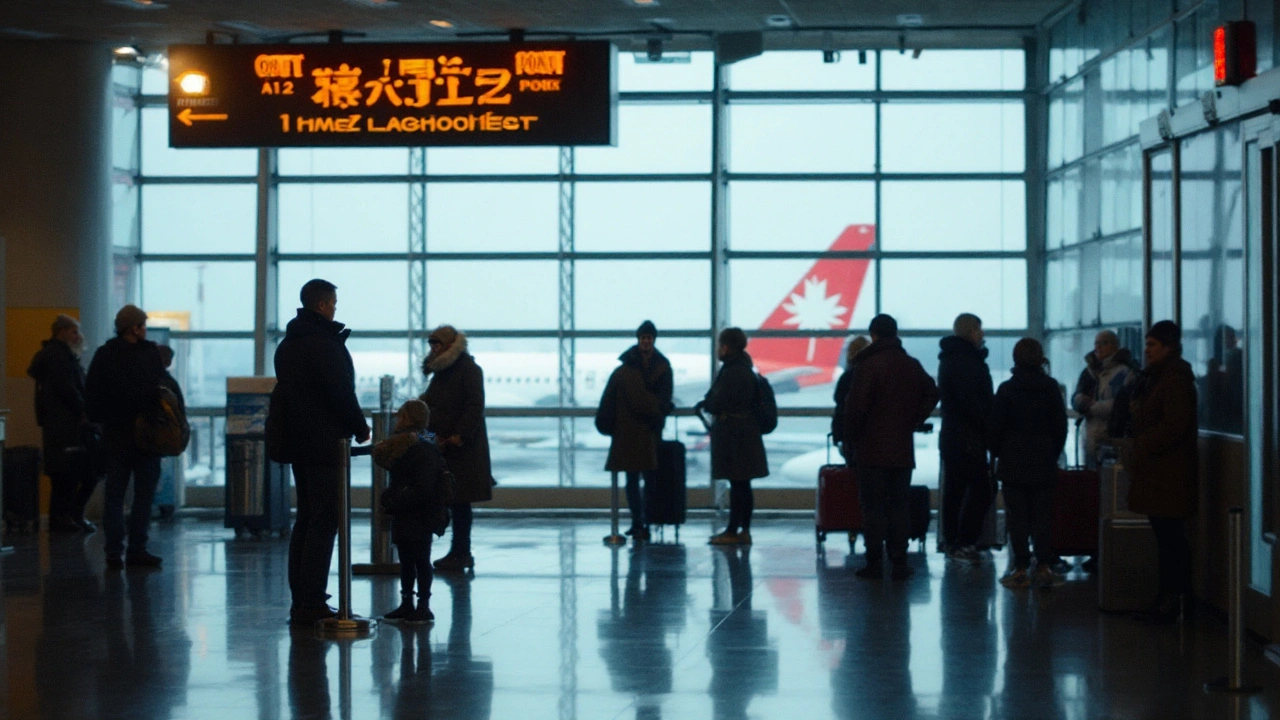You booked the trip, not the fever. The good news: most flu exposure risk while traveling is predictable-and preventable. You can’t sterilize an airport, but you can stack the odds in your favor with a few smart habits, the right timing on vaccines, and a carry-on kit that actually works on the road. I fly a lot out of Tampa, and these are the exact steps I use to stay healthy during peak season and long-haul flights.
- TL;DR: Get the seasonal flu shot at least 2 weeks before wheels-up; pack a simple health kit; use a well-fitted mask in crowded indoor spots; wash or sanitize hands after high-touch moments; sit by the window if you can.
- On planes: focus on hands, air, and face. Clean what you touch, sip water hourly, and avoid touching your eyes, nose, and mouth.
- If symptoms start: isolate as best you can, wear a high-filtration mask, hydrate, and contact a clinician early-antivirals work best within 48 hours.
- Rule of thumb: if you’re feverish, you’re contagious. Most people spread flu from 1 day before symptoms to about 5-7 days after.
- For high‑risk travelers (65+, pregnant, chronic conditions), talk to your clinician about timing, higher‑dose vaccines, and a plan for rapid antiviral access.
Plan Smart Before You Go
Your pre-trip prep does more to cut flu risk than anything you do mid-flight. Think in three buckets: vaccine timing, trip design, and your health kit.
flu travel tips
Get the shot early enough to matter. The seasonal flu vaccine takes about two weeks to build protection. In the U.S. (Northern Hemisphere), the main season runs roughly October through May. Southern Hemisphere season is April through September, and in the tropics flu can circulate year‑round. If you’re hopping hemispheres, get the current season’s vaccine before you go. Adults 65+ should ask about high‑dose or adjuvanted options. CDC guidance (2025): annual vaccination for everyone 6 months and older, barring rare contraindications.
“CDC recommends annual influenza vaccination for everyone 6 months and older with rare exceptions. Vaccination is the first and most important step in protecting against flu.” - U.S. Centers for Disease Control and Prevention
Two-week timeline: book your shot no later than 14 days pre-departure. If you’re leaving sooner, get it anyway; any protection helps, and you may benefit mid-trip or on the way home.
Design the trip to reduce exposure. You can lower risk before you even pack:
- Seats: Pick a window seat. A 2018 Emory/Georgia Tech study found aisle seats had more close-contact exposures on flights. Windows limit passersby and your own wandering.
- Timing: If you can, avoid peak flu months for long-hauls with tight connections. Early morning flights tend to be less crowded and cleaner.
- Layovers: Choose longer, less crowded connections versus short sprints through packed hubs. More time = less rushing = fewer face touches and slip-ups.
- Insurance: If the trip is costly, buy travel insurance with “trip cancellation for medical reasons,” plus travel medical or telehealth access. Keep the policy and hotline numbers in your wallet and phone.
Pack a streamlined health kit. Keep it TSA-compliant and always within reach in your personal item:
- High-filtration masks (N95/KN95/KF94) in a clean pouch; replace if damp or after 8 hours of use.
- Travel-size hand sanitizer (max 3.4 oz/100 mL under standard 3‑1‑1 rule) with 60%+ alcohol.
- 70% alcohol wipes or disinfectant wipes for seat areas; also handy in taxis and hotel remotes.
- Saline nasal spray and lip balm (dry cabin air cracks defenses).
- Thermometer and small oral rehydration packets.
- Fever/pain relief (acetaminophen or ibuprofen; check interactions with your meds).
- Zinc lozenges if you use them at first sign of a sore throat (evidence is mixed; not prevention, but may modestly shorten symptom duration if started early).
- Prescription antivirals if advised by your clinician (e.g., oseltamivir). These help most when started within 48 hours of symptom onset.
- Your regular meds in original containers, plus an extra few days’ supply.
Sleep, stress, and food-the boring but big levers. The week before you travel, bank sleep (7-9 hours), hydrate, and keep workouts easy. Heavy drinking and late nights the day before departure prime you for a sore throat by the time you hit the hotel. On flight day, eat something simple with protein and fiber; aim for water over booze or sugary drinks until you land.
Quick vaccine myths check: No, the flu shot can’t give you the flu. Mild side effects like a sore arm or low-grade fatigue are normal. If you’re sick with a high fever on shot day, reschedule. Yes, you can get flu and COVID vaccines at the same visit if you’re due-different viruses, different vaccines, and coadministration is allowed.
| Pre-Trip Action | When to Do It | Why It Helps |
|---|---|---|
| Flu vaccination | ≥14 days before departure | Time for antibodies to build and reduce severe illness risk |
| Seat selection (window) | At booking/check-in | Fewer aisle contacts; less exposure to passing passengers |
| Health kit packed | 2-3 days prior | Prevents last-minute omissions; keeps essentials handy |
| Hydration ramp-up | 48 hours prior | Protects mucous membranes in dry cabins |
| Insurance review | Within 14 days of booking (often required) | Qualifies for pre-existing condition waivers; clear claim terms |

On the Move: Airports, Planes, Trains, Rideshares, and Hotels
Think touch, air, and time. Control those, and you control most of the risk.
Airports and stations: keep your hands honest.
- Sanitize after these high-touch moments: security bins, escalator rails, check-in kiosks, elevator buttons, and boarding passes. Treat your phone like a third hand-wipe it after security.
- Mask up in crowded queues, jet bridges, shuttles, and gate areas (especially during local flu surges). Fit beats brand; pinch the nose, snug the cheeks.
- Skip touching your face. If you must, sanitize first. This single habit change cuts a shocking amount of risk.
- Spread out when you can. Empty gates, outdoor spaces, or quiet corners reduce your dose of whatever’s in the air.
On the plane: control your 6-square feet. Modern jets have aggressive HEPA filtration with frequent air exchanges, but your row is your world. Focus there.
- Wipe down: seat belt buckle, armrests, tray table (top and bottom), window shade, and touch screen. Let surfaces stay wet for the contact time listed on the wipe.
- Window seat if possible; keep the overhead vent on low/medium angled to blow air down in front of your face, creating a small clean-air curtain.
- Drink water-about 8 ounces per flight hour is a decent rule. Bring a reusable bottle and fill it after security.
- Use saline spray just before boarding and mid-flight for long hauls; moisture helps your nose trap invaders.
- Mask during boarding and deplaning when the cabin is packed and ventilation may be inconsistent.
- Avoid aisle roaming. Minimize trips except for stretching and bathroom breaks.
- Food and drinks: quick sips with mask back on. If your seatmate is coughing, eat when they’re not.
Trains, buses, and rideshares: mind the micro-environment.
- Crack the window slightly in a rideshare if the weather allows; sit diagonal from the driver to increase distance.
- On trains, choose a less crowded car; face air vents rather than other passengers.
- In taxis, sanitize hands after handling seatbelts, card machines, or door handles.
Hotels and rentals: aim for air and hands, not paranoia.
- Crack a window or run HVAC on fresh-air mode if available; a few minutes of airing out helps.
- Wipe the TV remote, light switches, and handles. Wash your hands when you walk in-habit loop.
- Housekeeping: you can request fewer visits to reduce room traffic, or daily if you prefer; either way, keep your mask handy when staff are in the room.
- Gym? Wipe gear, bring your own towel, and sanitize after. Early morning hours tend to be less crowded.
Food and social plans without derailing fun.
- Pick outdoor seating when it’s nice. Indoors, choose airy spots away from the bar crush.
- Share plates? Make a serving plate to avoid constant utensil swapping.
- Go easy on alcohol on flight day and the first night; dehydration and poor sleep open the door to illness.
What the numbers say about risk-and what to do about it.
| Setting | Relative Risk | Key Move | Why |
|---|---|---|---|
| Boarding lines/jet bridge | Higher | Wear a well-fitted mask | Close crowding with variable ventilation |
| Seated on aircraft | Moderate near sick seatmates | Window seat + air vent on low | HEPA helps, but proximity dominates exposure |
| Airport gate area | Moderate to higher | Space out; sanitize after touching surfaces | High-touch surfaces and mixed air flows |
| Hotel room | Lower (solo) | Ventilate briefly; hand hygiene | Risk mainly from what you touch |
| Indoor bars/packed events | Higher | Prefer outdoor/less crowded options | Prolonged close contact, louder talking, shared air |
Context: CDC estimates U.S. seasonal flu causes between 9-41 million illnesses, 140,000-710,000 hospitalizations, and 12,000-52,000 deaths most seasons. That range swings with the strain and the year, but the levers above help every season.

If Symptoms Hit: What to Do, Who to Call, and When to Push Pause
Flu moves fast. Act within the first 24-48 hours and you can cut severity and avoid derailing your whole trip-or someone else’s.
Spot the difference. Flu generally starts abruptly with fever, chills, headache, cough, sore throat, runny or stuffy nose, muscle aches, and fatigue. Gastro symptoms can happen, especially in kids, but classic flu is respiratory. COVID and RSV can look similar; if you can, test for COVID to avoid confusion, especially before seeing older relatives or high-risk colleagues.
Immediate steps if you feel sick on the road:
- Mask up with a high-filtration mask and reduce contact. You’re likely contagious from 1 day before symptoms until at least day 5-7.
- Hydrate, rest, and control fever with acetaminophen/ibuprofen as appropriate.
- Contact a clinician or telehealth. Antivirals like oseltamivir (Tamiflu) or baloxavir (Xofluza) work best within 48 hours. They may still help later if you’re high risk.
- Inform your travel companions and consider modifying plans-private activities, takeout meals, or a rest day.
- If you have red flags (shortness of breath, chest pain, confusion, persistent high fever, dehydration, worsening symptoms), seek in‑person care promptly.
When to cancel or delay travel: If you have a fever and feel lousy, flying spreads misery and germs. Most airlines and insurers accept a doctor’s note for illness‑related changes under your policy terms. As a rule: wait until at least 24 hours fever‑free (without meds) and you’re improving.
Return-to-normal cheat sheet.
| Scenario | Typical Guidance | Notes |
|---|---|---|
| Fever present | Delay travel; isolate as feasible | Contagious; hydrate and rest; seek medical advice |
| 24 hours fever-free without meds | Consider resuming travel with precautions | Mask in crowded spaces; keep hands clean |
| Day 5-7 after symptom onset | Most adults no longer contagious | Kids and immunocompromised may shed longer |
Mini-FAQ
- Should I wear a mask the whole flight? Do it during the highest-risk times: boarding, deplaning, and any stretch when the cabin feels crowded. Keep one on if your seatmate is coughing or the flight is full.
- Which mask? N95/KN95/KF94 or a well-fitted surgical mask. Fit is everything-no big gaps.
- Do disinfecting wipes actually help? Yes-especially on tray tables and screens, which are touched often. Let surfaces stay wet for the contact time on the label.
- Is the air on planes dirty? It’s filtered aggressively through HEPA and exchanged often. Most risk is from close contact within a few rows.
- What about vitamins? Eat well and keep vitamin D in the normal range, but supplements aren’t a substitute for vaccines, sleep, and hygiene.
- Can I get a flu shot and leave the next day? Yes, but immunity builds over about two weeks. Get it as early as you can.
- Kids and pregnant travelers? Flu vaccination is recommended in pregnancy; kids 6 months+ should be vaccinated. If either get sick, call their clinician early; antivirals may be advised.
Checklists you can copy
Carry-on health kit
- High-filtration masks (2-3)
- Hand sanitizer (60%+ alcohol, travel size)
- Disinfecting/alcohol wipes
- Saline nasal spray, lip balm
- Thermometer, oral rehydration packets
- Pain/fever meds; any daily prescriptions
- Zinc lozenges (optional), tissues
- Insurance card, policy details, clinician contact, telehealth app login
Boarding routine
- Mask on in the jet bridge
- Wipe tray, armrests, buckle, screen, window shade
- Vent on low, aimed just in front of your face
- Hand sanitize after stowing bags and buckling up
Hotel arrival
- Wash hands as soon as you enter
- Crack window or cycle HVAC on fresh air (if possible)
- Wipe remote, light switches, door handles
- Set out your health kit for easy access
Rules of thumb that stick
- Two weeks for vaccines, two days for antivirals. Aim for both.
- 8 ounces of water per flight hour.
- 20 seconds of handwashing after high-touch moments.
- Window seat beats aisle for exposure.
- Fever today? Travel tomorrow-after you’re 24 hours fever-free without meds.
Risks and mitigations (quick hits)
- High-risk travelers (65+, chronic heart/lung disease, diabetes, immunocompromised, pregnant): prioritize vaccination; consider high-dose/adjuvanted vaccines; carry a plan for rapid antivirals; mask consistently in crowded indoor spots.
- Medication interactions: If you have high blood pressure or glaucoma, check decongestants (like pseudoephedrine/phenylephrine) with your clinician.
- Antibiotics: Not for flu. It’s viral. Only take antibiotics if a clinician diagnoses a bacterial complication.
- Allergies/asthma: Keep rescue inhalers and action plans handy; respiratory viruses can flare symptoms.
If plans go sideways: troubleshooting
- Got sick two days before departure? Call your clinician about antivirals, rest, and whether to postpone. Use insurance if covered; many policies need a physician’s note for trip changes.
- Symptoms mid‑flight? Mask up, hydrate, and let a flight attendant know if you need assistance. Skip alcohol; stick to water or tea.
- No access to a clinic abroad? Use your insurer’s telemedicine or a reputable local clinic network. Many hotel concierges can connect you quickly; confirm fees first.
- Travel partner gets sick? Shift to outdoor meals, open windows when possible, wear masks indoors, and don’t share drinks or utensils. Consider separate beds for a few nights.
Why this works
Flu spreads mainly through droplets and short-range aerosols from infected people, plus the occasional contaminated surface. On the road, you control exposure by shaping space (distance, ventilation), time (shorten close contacts), and gateways (hands and face). Vaccination shrinks the odds of severe disease. Hydration and sleep shore up your defenses. The rest is just habits you can run on autopilot, whether you’re sprinting through ATL or cruising into a quiet gate at TPA.
Sources I trust: CDC for vaccine and antiviral guidance; WHO for global flu surveillance; IATA and aircraft manufacturers for cabin air data. Always check your local public health updates where you’re flying.


Written by Guy Boertje
View all posts by: Guy Boertje